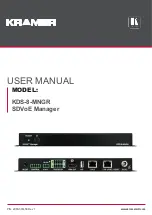
86
D14049.05
February 2009
Grey Headline
(continued)
TANDBERG
VIDEO COMMUNICATIONS SERVER
ADMINISTRATOR GUIDE
Introduction
Getting started
Overview and
status
System
configuration
VCS
configuration
Zones and
neighbors
Call
processing
Bandwidth
control
Firewall
traversal
Appendices
Applications
Maintenance
Clustering and peers
Configuring clusters
!
Systems that are configured as peers must not also be
configured as neighbors to each other, and vice versa.
!
We recommend that peers in a cluster are deployed on
the same LAN as each other so that they can be
configured with the same routing information such as
local domain names and local domain subnet masks. If peers are
deployed on different LANs, there must be sufficient connectivity
between the networks to ensure a low degree of latency between
the peers - a maximum delay of 15ms one way, 30ms round-trip.
Prerequisites
Before creating your cluster:
Ensure that all VCSs to be added to the cluster have the same
•
software version installed.
Ensure that each VCS to be added to the cluster is configured
•
with a different
system name.
Ensure that each VCS to be added to the cluster has a
•
different
LAN
configuration (i.e. a different IPv4 address and a
different IPv6 address, where enabled).
Ensure that all VCSs to be added to the cluster have identical
•
sets of
option keys
installed.
Determine which VCS is to be the master and configure it with
•
the settings you wish to apply to the entire cluster.
Enabling H.323
H.323 signaling is used for both endpoint location searching
and sharing bandwidth usage information with other peers in the
cluster. This means that H.323 must be enabled on all peers,
even if all endpoints in the cluster are SIP only. To enable H.323,
navigate to
VCS configuration > Protocols > H.323
and ensure
that
H.323 mode
is set to
On
.
Enabling SSH
The replication of all configuration (including FindMe data)
between peers is performed using SSH, so this service must
be enabled on all peers. To enable SSH, navigate to
System
configuration > System
and ensure that
SSH service
is set to
On
.
Clustering also requires access to the root account via SSH. To
configure this, see the section
Accessing the root account over
SSH and Telnet
.
Running the clustering script
On each peer in the cluster, log in as
root
and run the cluster
configuration script. A full step-by-step guide on using this
script and configuring clusters is available in the
TANDBERG
Deployment Guide - Creating a Cluster of VCS X4 peers [27]
.
Setting configuration for the cluster
!
You must make all configuration changes on the master
only. Any changes made on other peers will not be
reflected across the cluster, and will be overwritten the
next time the master’s configuration is replicated across the
peers.
To set configuration for the cluster:
Log in to the master VCS and make the configuration changes.
1.
You may need to wait up to one minute before the change is
updated across all peers in the cluster.
Changing the master
The only circumstances in which you should change a cluster's
configuration master are:
if the original master peer has failed. In such a case, you
•
must log in to every other VCS in the cluster and change the
configuration master on each.
Note that if the master fails, the remaining peers will continue
to function normally, except they will no longer be able to copy
their configuration from the master so may become out of
synch with each other.
if you wish to take the master out of service. In such a
•
case, you must log in to the master peer and change the
configuration master to another peer. (If you use any other
VCS to change the configuration master, this setting, like all
other configuration, will be overwritten when that peer next
replicates its configuration from the master.)
To change the master peer:
Navigate to the
1.
Clustering
page (
VCS configuration >
Clustering
). This page shows all peers in the cluster, numbered
from 1 to 6.
From the
2.
Configuration master
drop-down menu, select the
number of the peer (as it appears in the list below) that you
wish to make the master.
Click
3.
Save
.
You may need to wait up to one minute before the change is
updated across all peers in the cluster.
Using TMS
Clusters can be monitored from TANDBERG Management Suite
(TMS) version 12.1 and above. For full information, refer to the
TMS documentation.
!
If you were managing a VCS version X3 cluster using TMS
and have upgraded to VCS version X4, you must run the
clustering script (see the section
Running the clustering
script
for details) in order to manage the cluster from TMS.
For peers running VCS version X3, TMS performed
automatic replication across the peers. For peers running
VCS version X4, TMS does not perform the replication -
instead, configuration information is pulled from the master by
each peer.
Listing other peers in the cluster
If the local VCS is part of a cluster, the
Clustering
page lists the
IP addresses of all the peers in the cluster to which this VCS
belongs, including the IP address of the VCS to which you are
currently logged in.
To view the
Clustering
page:
VCS configuration > Clustering
•
.
To view this information from the CLI:
xConfiguration Alternate
•
s
















































